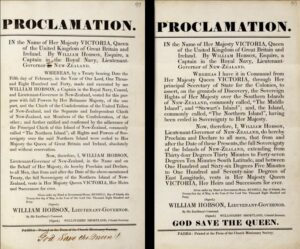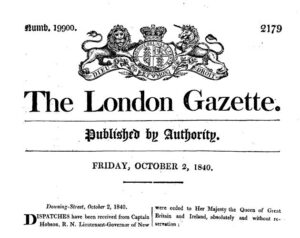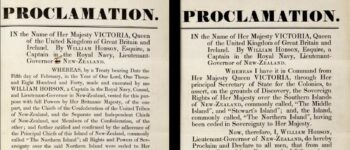1840: The Proclamations of Sovereignty
May 21, 2022
By AHNZ

From today in history, 21 May, 1840, New Zealand became a British Colony with all inhabitants subject to the laws of England. This, our legal founding, was accomplished by the William Hobson Gang by issuing two Proclamations of Sovereignty. One was for the North Island, one was for the South Island and Stewart Island.
Things had been moving very fast. Captain William Hobson had only just ‘crowned’ himself Lieutenant Governor of New Zealand 15 weeks prior. We were now a sub-unit of the Colony of New South Wales. Ref. 1840: Hobson Crowns Himself, AHNZ
The retrospective sovereignty document called The Treaty of Wantangi, was even newer at just 14 weeks old at this stage. Hobson liked to have indigenous consent if he could get it, and to supplant the Declaration of the Independence of New Zealand (1930,) but he obviously didn’t need it and wasn’t waiting for it. HMS Herald was away discovering tribes, giving them a crash-course in handwriting, and getting them to use their new penmanship to sign away their sovereignty to New South Wales for Queen Victoria. Hobson wouldn’t know until his gang affiliates on Herald, Captain Joseph Nias and Major Thomas Bunbury, returned with the Herald-Bunbury Copy of the Treaty on July 2nd how things turned out.¹ Ref. 1840: Tour of Duty or Tour of Booty?, AHNZ
The Hobson Gang did know, first hand, that Hokianga Maoris rejected their Treaty because they literally threw it and the bribery blankets back in their faces! Ref. 1840: Hobson’s Treaty Refused, Blankets Thrown Back At Him, AHNZ
The North Island Proclamation of Sovereignty was retrospectively dated to the signing of the Treaty of Waitangi (even as it was still being signed) and lied by saying this had been done on February 5th when it was really the 6th. In haste, Hobson’s Gang also accidentally got their figures wrong by accidentally proclaiming sovereignty somewhere to the east of Japan when they had been meaning New Zealand. Ref. 1841: The Colony of New Zealand, AHNZ
 Sovereignty over The South Island was not back-dated but began on 21 May, 1840, on the basis of Discovery. Hobson said that “from a perfect knowledge of the uncivilized state of the natives,”² the advice of Governor Gipps, it was now part of his political territory on behalf of Queen Victoria.
Sovereignty over The South Island was not back-dated but began on 21 May, 1840, on the basis of Discovery. Hobson said that “from a perfect knowledge of the uncivilized state of the natives,”² the advice of Governor Gipps, it was now part of his political territory on behalf of Queen Victoria.
The errors were fixed in post-production. Hobson’s Proclamations were printed in The London Gazette on 2 October, 1840, and, abracadabra, sovereignty acquired.
The Crown will not be responding to the findings of the Waitangi Tribunal in its stage one report that Ngapuhi did not cede sovereignty…Barrister Andrew Irwin who represents the Crown says, “Hobsons proclamations in May 1840 and the publication of those proclamations later that year in October and the extension of British Sovereignty to New Zealand was completed.” He came under cross-examination from the Waitangi Tribunal Judge Craig Coxhead, “So when you’re talking about Crown Sovereignty of New Zealand incontrovertible, are you talking about the legal sovereignty or the effective sovereignty or both?” The Crowns’ reply was, “Ahh the legal sovereignty.” – Crown rejects finding that Ngapuhi did not cede sovereignty, Te Ao Maori News (2017)
“As a matter of interest, The Charter of 1840 specified the equivalent coordinates for New Zealand in the northern hemisphere of the world. This was a cut’n paste of Hobson’s own hasty Hobson’s Proclamation of Sovereignty (21 May 1840) over all New Zealand¹. It was later moved but for a time the Colony of New Zealand was, legally speaking, located in North Pacific empty water about 3000km off the east coast of Japan.” – 1841: The Colony of New Zealand, AHNZ
“Within an hour of hearing of President Wakefield, his council and his magistrates, Hobson proclaimed, on the 21st May, 1840, the Queen’s sovereignty over the Northern Island on the ground of cession by “the chiefs of the confederation of the united tribes, and the separate and independent chiefs.”By a separate Proclamation on the same day he asserted the sovereign rights of the Queen over all the Islands of New Zealand, averring that he had “it in command”so to do. He explained to the Secretary of State that in thus acting he “yielded to the emergency of the case arising out of the events at Port Nicholson, and was supported by the advice of Sir George Gipps, previously given. According to my opinion, unaided by legal advice, the proceedings of the Association at Port Nicholson amount to high treason. They have usurped the power of Her Majesty in establishing a constitution, and in appointing magistrates.”They had levied taxes, and “unjust as well as illegal magisterial authority”had been exercised.” – History of New Zealand, G. W. Rusden (1883); NZ Electronic Text Collection, Victoria University
“It seems that from the moment The State came to New Zealand it tried to put all the pieces of Lepidoptera Britainia back together again. It tried defining us as New Ulster and New Munster.” – Lepidoptera Zealandia, AHNZ
Hobson was in a great rush to ram through his erroneous (and nation-founding) documents that New Zealand’s legal system depends upon today. He was having a similar anxious moment that James Busby experienced in 1835 when the threat of rival ‘Sovereign King of New Zealand’ Baron De Thierry spurred him to hurriedly cobble together the Declaration of the Independence for the uncomprehending natives. Hobson had been provoked by a whining defector of the Port Nicholson Settlement, Dudley Sinclair, and an escaped captain fleeing from the justice of the Port Nicholson Settlers’ Council. Hobson, furious, had the scatter-shot proclamations issued within the hour. Chief Henchman (Colonial Secretary,) Willoughby Shortland was sent to the Cook Straight settlement, armed, to crush the independent New Zealanders. Ref. 1840: Dissolving the Port Nicholson Settlers’ Council, AHNZ
The State swept away a New Zealand that was made up of a rich tapestry of independent little settlements, including those of the Maori tribes. We could have remained in this glorious Anarchist state. We could have been Lepidoptera Zealandia. But, The State does not suffer rivals.
Happily, the Port Nicholson Settlers (aka Wellington) to this day celebrate their anniversary on 22 January. That date is a full week before the Hobson Gang landed and started distributing various proclamations of sovereignty that still hang over us today. Ref. 1840: Wellington Anniversary, AHNZ
—
1 Ref. Herald Bunbury treaty copy, NZ History.gov
2. Ref. Hobson to Secretary of State for War and the Colonies John Russell; p61 Crown Colony Government in New Zealand, McLintock (1958)
Ref. London Gazette, 2 October, 1840
Image ref. Proclamations of sovereignty, Archives NZ, Flickr
 Like Comment Share
Like Comment Share





